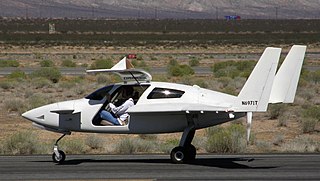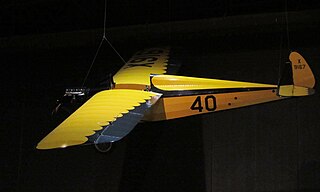Related Research Articles

The Rutan VariEze is a composite, canard aircraft designed by Burt Rutan. It is a high-performance homebuilt aircraft, hundreds of which have been constructed. The design later evolved into the Long-EZ and other, larger cabin canard aircraft. The VariEze is notable for popularizing the canard configuration and moldless glass cloth composite construction for homebuilt aircraft.

The Rutan Quickie is a lightweight single-seat taildragger aircraft of composite construction, configured with tandem wings.

The Scaled Composites Pond Racer was a twin-engine twin-boom aircraft developed for Bob Pond by Burt Rutan and his company Scaled Composites.

The Velocity Model 173 SE is an entry level canard pusher aircraft from Velocity Aircraft. The four seat, rear engine aircraft may be powered by a 160 hp (120 kW) Lycoming IO-320 or a 200 hp (150 kW) Lycoming IO-360 engine.

The Velocity XL is an American amateur-built aircraft, produced by Velocity, Inc. It is an enlarged version of their Velocity SE canard pusher design.

The Rutan VariViggen is a homebuilt aircraft designed by Burt Rutan. The aircraft is a tandem two-seater of primarily wooden construction with a delta wing and a canard foreplane. The VariViggen is powered by a 150 hp Lycoming O-320 aero engine in pusher configuration. The prototype was designated Model 27, and the production version was Model 32.

The Beck-Mahoney Sorceress was a racing staggerwing biplane originally designed by the father and son team of Lee and Seldon Mahoney with later improvements accomplished by pilot Don Beck.

Dago Red is a North American P-51 Mustang (44-74996), restored as a competitive air racer by Frank Taylor in 1981. Dago Red holds several world records, including the 15 km (517.323 mph) set in 1983. Frank Taylor piloted the plane to most of its world records in the 1980s.

The Viking Dragonfly is an American amateur-built aircraft, designed by Bob Walters and produced by Viking Aircraft LLC of Elkhorn, Wisconsin. The aircraft is supplied as a kit or as plans for amateur construction.

The Sharp Nemesis NXT is a sport-class kit-built aircraft. It is designed for air racing. It was designed by Nemesis Air Racing's president Jon Sharp, as a follow-on to the Sharp Nemesis. It is a two-seat, single engine, low wing, retractable gear kit aircraft. As designed, the aircraft is powered by a Lycoming TIO-540-NXT Thunderbolt six-cylinder engine.

The Sharp DR 90 Nemesis is a Formula One racing aircraft designed by Jon Sharp and built at the Mojave Airport by the Nemesis Air Racing Team. The aircraft is powered by a modified Continental O-200 piston engine.

The Church Midwing JC-1, a.k.a. Church Mid-Wing Sport, is a midwing racing aircraft designed by James Church using the fuselage of a Heath aircraft.

Tsunami was an experimental purpose-built racing aircraft designed and built in the United States during the 1980s. After a short undistinguished career Tsunami crashed, killing its designer, John Sandberg, on 25 September 1991.

The Folkerts SK-2, also known as Speed King Two, "Toots" and "Miss Detroit" was a racer built for the 1936 National Air Races

The Wittman D-12 "Bonzo" was an air racer designed by Steve Wittman for the Thompson Trophy races. The aircraft's top speed of 325 mph (523 km/h) made it faster than any United States military aircraft of the era.

The Quickie Q2 or Q2 is a two-seat version of the unique Rutan Quickie, produced in kit form by the Quickie Aircraft Corporation founded by Tom Jewett and Gene Sheehan. Canadian Garry LeGare was involved in the design.
The Mace-Trefethen R-2 Shark is an American single place racing aircraft designed in the 1970s.

The Williams-Cangie WC-1 Sundancer is an American homebuilt biplane racing aircraft that was designed by Art Williams and Carl Cangie and built by Ralph Thenhaus in 1974. Plans were at one time available from Williams' company, the Williams Aircraft Design Company of Northridge, California. Only one was built.

The Williams W-17 Stinger is an American homebuilt racing aircraft that was designed for Formula One Air Racing by Art Williams and produced by his company, Williams Aircraft Design of Northridge, California, introduced in 1971. The aircraft was at one time available in the form of plans for amateur construction, but only one was ever constructed.

The Dickey E-Racer, also called the Sierra Delta E-Racer, is an American homebuilt aircraft that was designed by Shirl Dickey and produced by Shirl Dickey Enterprises of Phoenix, Arizona, first flown in 1984. When it was available the aircraft was supplied in the form of plans for amateur construction, with some parts available to facilitate faster construction.